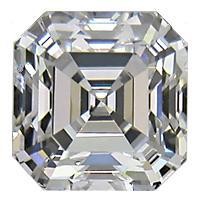The Asscher Cut is a distinctive and elegant diamond shape, known for its square shape and step-cut faceting. It is similar to the emerald cut, but it features larger step facets and a more defined, square outline. The Asscher cut was first developed in 1902 by the Asscher brothers, a renowned family of diamond cutters in Amsterdam, and has become a popular choice for those seeking a vintage or Art Deco-style diamond.
Characteristics of Asscher Cut Diamond
Shape:
The Asscher cut is a square shape with cut corners, forming an octagonal appearance. The corners are typically beveled, creating an elegant, almost “octagon-shaped” look. This shape gives the diamond a vintage and timeless appeal.
Faceting Style:
The step-cut faceting involves parallel facets that descend in a series of steps. This style creates a hall of mirrors effect, where light reflects off the facets in a dramatic, shimmering manner. The larger facets allow you to see the diamond’s clarity more easily, which makes clarity a very important factor when selecting an Asscher cut diamond.
Brilliance:
Unlike brilliant cuts, which are designed to maximize sparkle through more facets, the Asscher cut is known for its depth and clarity rather than its brilliance. The step-cut nature gives the diamond a more subdued, sophisticated sparkle compared to other cuts like round brilliant or princess cut diamonds.
Size and Proportions:
Asscher cut diamonds are typically offered in square shapes, with proportions that are generally very specific to achieve the signature look. The diamond should have a length-to-width ratio of around 1.00 to 1.05, meaning the diamond is almost perfectly square.
Clarity and Colour:
The Asscher cut emphasizes the clarity of a diamond. Due to the large facets and open table, any inclusions or blemishes are more visible than they would be in a more brilliant cut. Therefore, it’s important to select an Asscher cut diamond with higher clarity, often at least VS1 or higher, to ensure a clean, clear appearance.
Regarding colour, the cut also tends to reveal the colour more clearly, especially in diamonds with lower colour grades. As such, higher colour diamonds (like those rated G or higher) are recommended for the Asscher cut to maintain the stone’s beauty.
Depth and Table Size:
A well-cut Asscher diamond has a deep, octagonal shape with a wide table. A shallow cut may lead to an undesirable look with less brilliance, while a deep cut may appear smaller for its carat weight.
Benefits of the Asscher Cut
Vintage Appeal: The Asscher cut is a favourite among those seeking a vintage or retro aesthetic. It was particularly popular during the Art Deco period and remains a popular choice for engagement rings and high-end jewellery.
Timeless Elegance: Its symmetrical and geometric design offers a sense of timeless beauty and elegance. The Asscher cut has an enduring appeal that stands out from modern cuts like the round brilliant or princess cut.
Emphasis on Clarity: The clean lines and large facets of the Asscher cut make it an excellent choice for diamonds with good clarity, as the cut enhances the diamond’s internal characteristics.
Less Sparkle, More Sophistication: The Asscher cut tends to have a more subdued sparkle, which some buyers find appealing for its refined, understated look. It’s perfect for those who prefer classic elegance over extreme brilliance.
Considerations When Buying an Asscher Cut Diamond
Clarity: Given the diamond’s faceting style, inclusions are more visible in an Asscher cut, so it’s important to choose a diamond with a high level of clarity (preferably VS1 or better).
Cut Quality: The quality of the cut is very important in an Asscher cut diamond. A poorly cut Asscher diamond can appear cloudy or dark due to poor light reflection. Ensure the diamond has well-proportioned facets.
Price: The Asscher cut is often priced similarly to the emerald cut and can be slightly less expensive than round brilliant cuts, depending on its size and quality. However, due to its vintage and unique appeal, it can also command a premium price in certain cases, especially for larger stones.
Asscher Cut vs. Other Square Cuts
Princess Cut: The princess cut is also a square-shaped diamond but features more facets, leading to greater brilliance and sparkle compared to the Asscher cut. The Asscher cut, however, has a more classic, vintage style and is often chosen for its geometrical elegance.
Radiant Cut: The radiant cut is another square diamond, but it features both step-cut and brilliant-cut facets, which give it more brilliance than the Asscher cut, which focuses on clarity and symmetry over sparkle.
